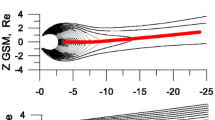Abstract
When the IMF turns southward, a great amount of magnetic energy is stored in the magnetotail, and the electric field across the magnetotail substantially enhances. As long as magnetic reconnection (MR) in the magnetotail initiates and continues, the magnetic field and plasma in the central plasma sheet are carried away to the near-Earth and down to the tail, the magnetic field and plasma in the lobe region enter the CPS and are involved in MR. We call this process“Continuous Lobe Reconnection (CLR)”. In this paper a detailed analysis of Cluster observation of MR through 2001–2003 is made. Plenty of CLR events are found that led to considerable changes of tail configuration, appearance of BBF, as well as large-scale bubbles in which both plasma temperature and number density substantially decrease. It is shown that in general CLR events last for dozens of minutes and have good correspondence to substorm initiation under the condition of continuous southward IMF.
Similar content being viewed by others
References
Rostoker, G., Akasofu, S. I., Baumjohann, W. et al., The roles of direct input of energy from the solar wind and unloading of stored magneto-tail energy in driving magnetospheric substorms, Space Sci. Rev., 1987, 46, 93.
McPherron, R. L., Russell, C. T., Aubry, M. P., Satellite studies of magnetospheric substorms on August 15, 1968, 9, Phenomenological model for substorms, J. Geophys. Res., 1973, 78, 3133.
Angelopoulos et al., Statistical characteristics of bursty bulk flow event, J. Geophys. Res., 1994, 99, 21257.
The Cluster and Phoenix Missions, Space Science Reviews, 1997, 79, 1–2.
Zong, Q. G., Wilken, B., Reeves, G. D., Daglis, I. A., Doke, T. et al., Geotail observations of energetic ion species and magnetic field in plasmoid-like structures in the course of an isolated substorm event, Journal of Geophysical Research-Space Physics, 1997, 102(nA6): 11409–11428.
Wilken, B., Zong, Q. G., Daglis, I. A., Doke, T. et al., Tailward flowing energetic oxygen-ion bursts associated with multiple flux ropes in the distant magnetotail: Geotail observations, Geophysical Research Letters, 1995, 22(n23): 3267–3270.
Zong, Q. G., Wilken, B., Woch, J., Mukai, T. et al., Energetic oxygen ion bursts in the distant magneto-tail as a product of intense substorms: Three case studies, Journal of Geophysical Research-Space Physics, 1998, 103(nA9): 20339–20363.
Jin, S. P., Hu, X. P., Zong, Q. G., Fu, S. Y. et al., A 2.5 dimensional MHD simulation of multiple-plasmoid-like structures in the course of a substorm, Journal of Geophysical Research-Space Physics, 2001, 106(nA12): 29807–29830.
Ma, Z. W. et al., Sudden Enhancement and partial disruption of thin current sheets in the magneto-tail due to Hall MHD effects, Geophysical Research Letters, 1998, 253277–253280.
Author information
Authors and Affiliations
Corresponding author
About this article
Cite this article
Cao, X., Pu, Z., Zhang, H. et al. Continuous lobe reconnection in the mid-tail and its relationship to substorms: Cluster observations of continuous lobe reconnection in the mid-magneto tail. Chin.Sci.Bull. 50, 2057–2063 (2005). https://doi.org/10.1007/BF03322801
Received:
Accepted:
Published:
Issue Date:
DOI: https://doi.org/10.1007/BF03322801




